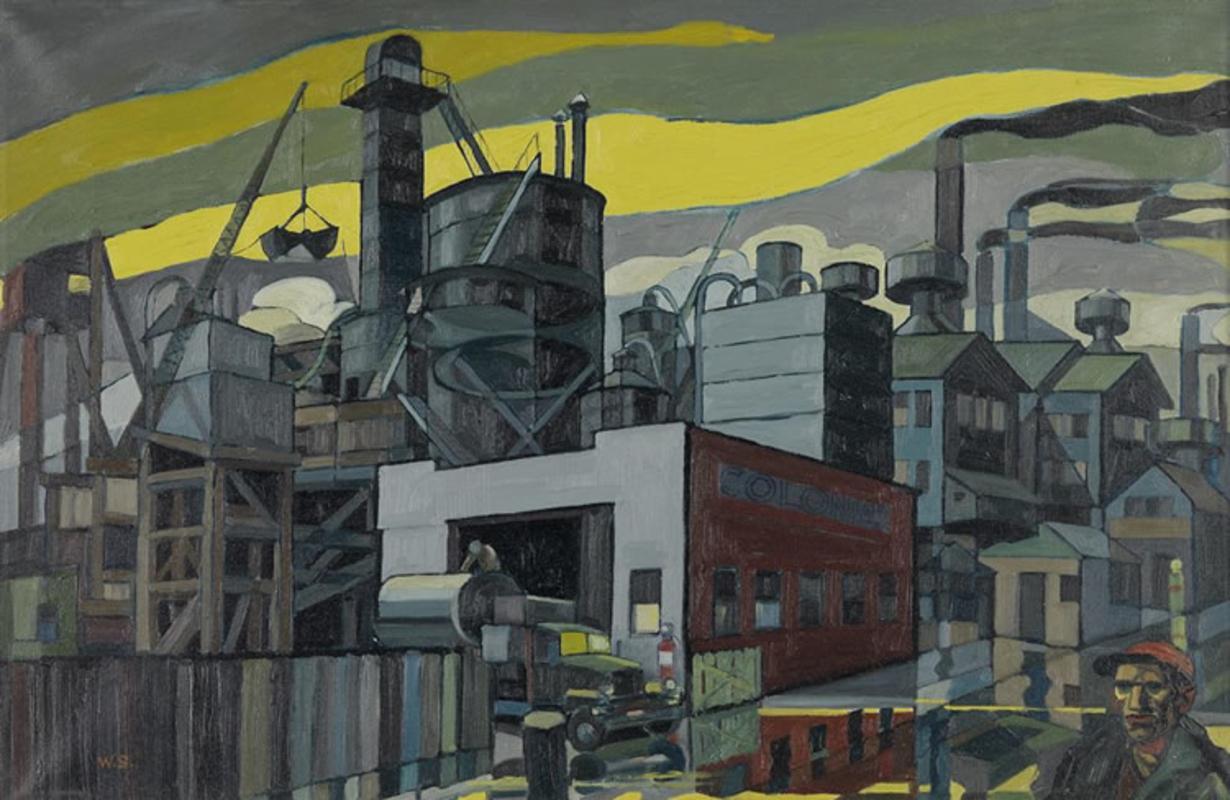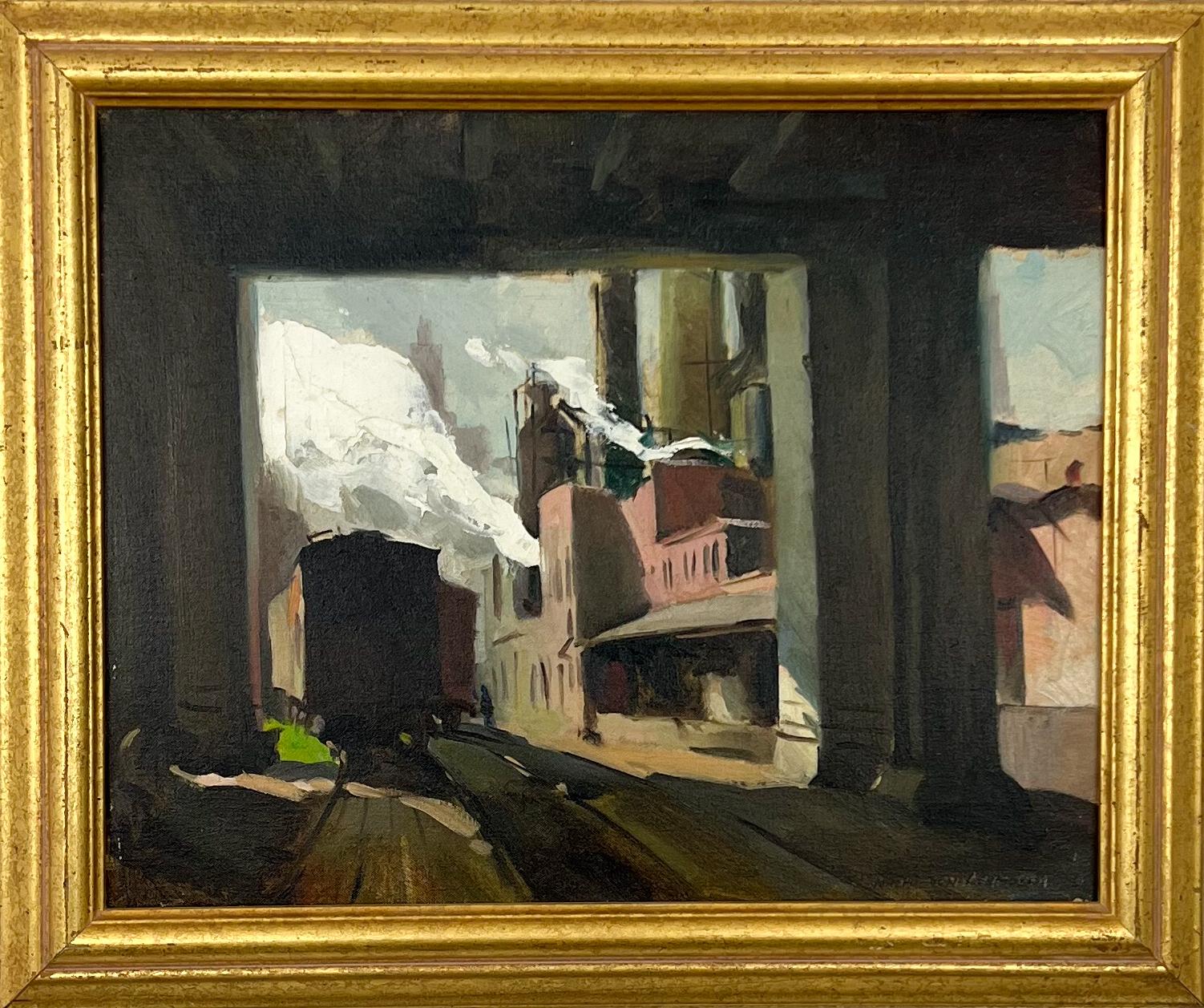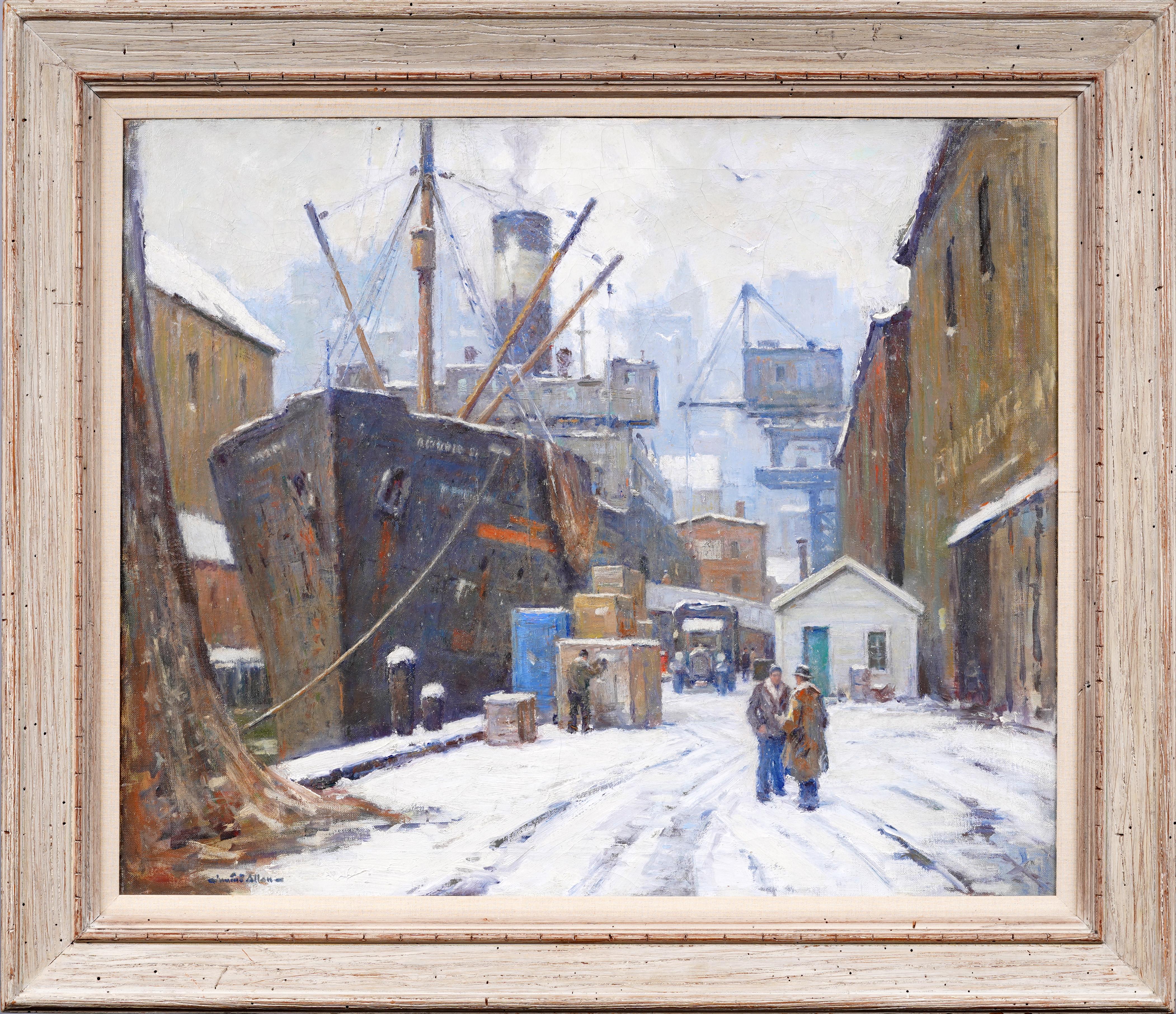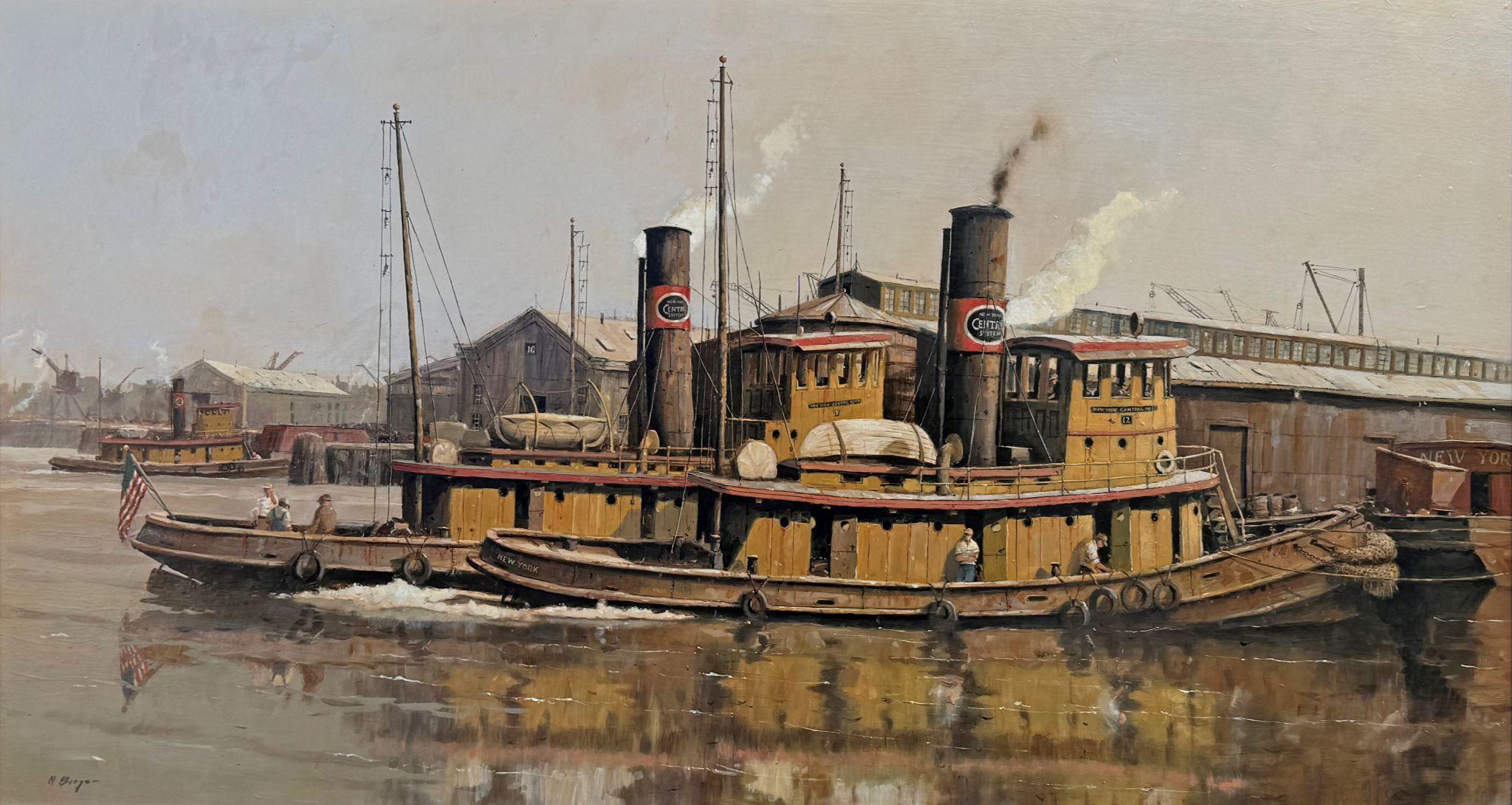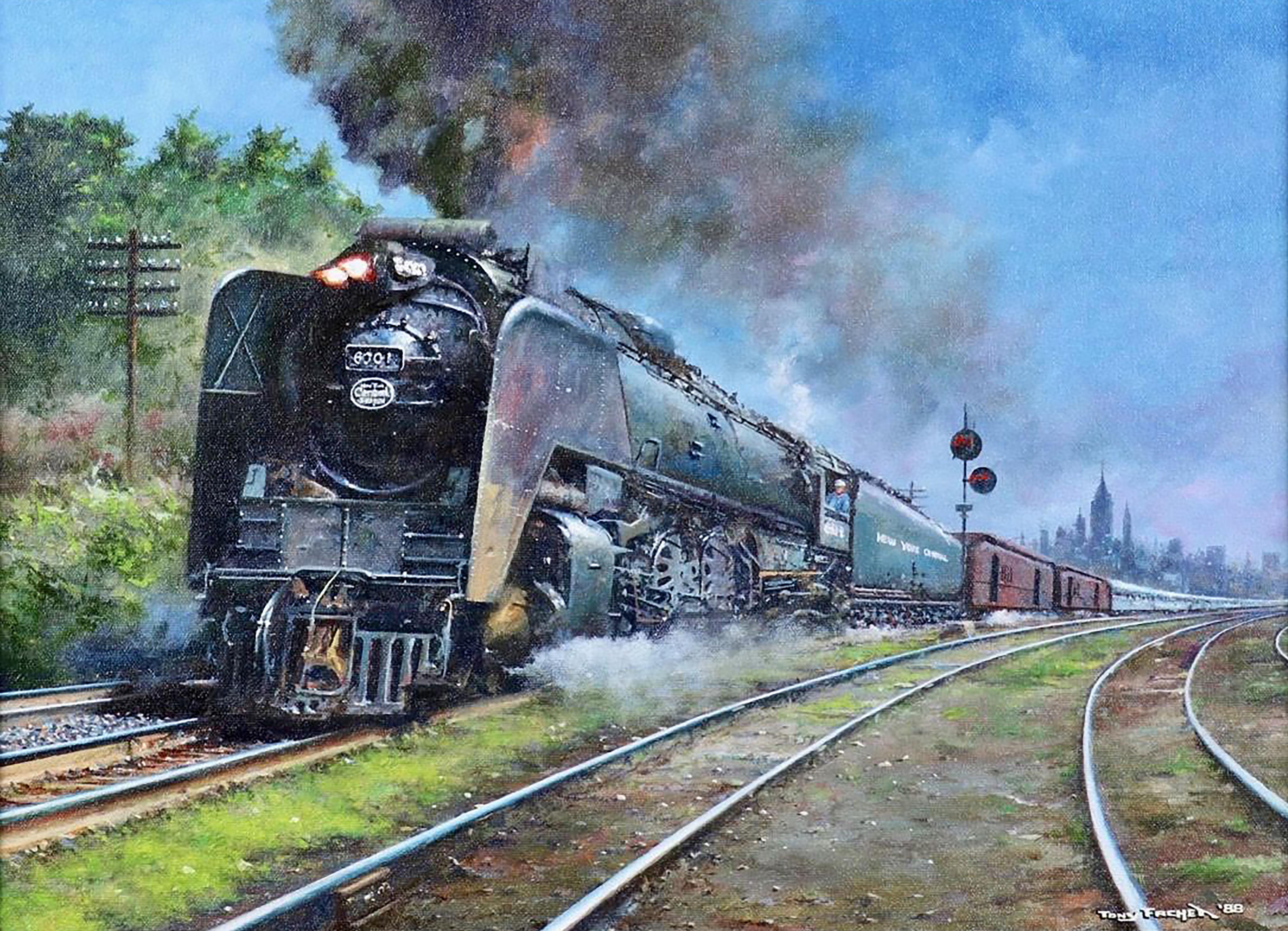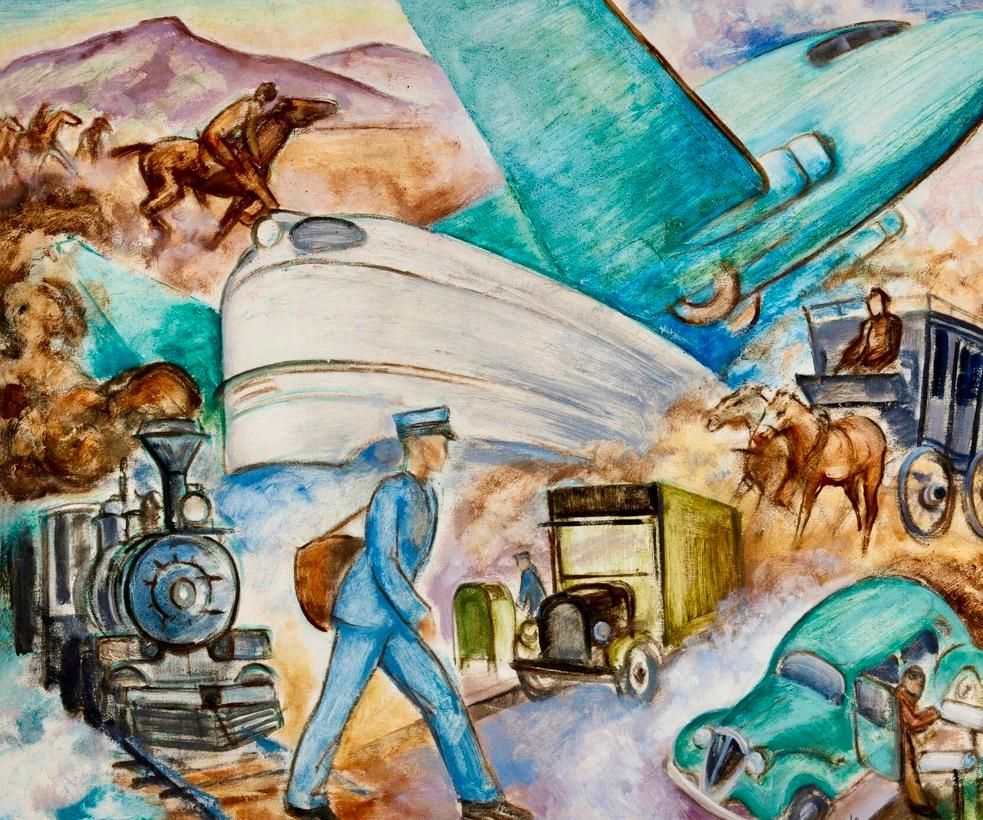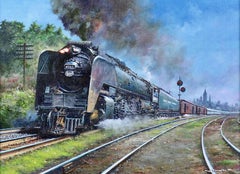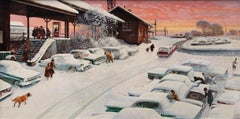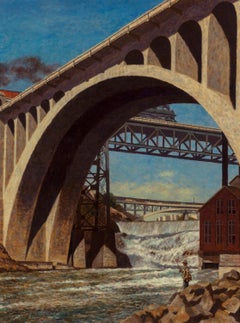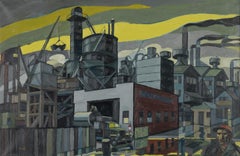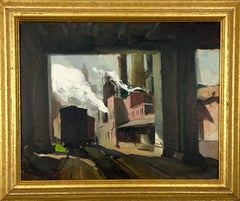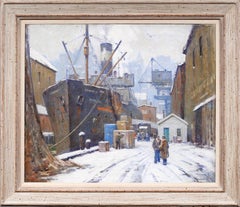Items Similar to Keeping Appointments with Convoys, Pennsylvania Railroad, 1943
Want more images or videos?
Request additional images or videos from the seller
1 of 6
John Ford ClymerKeeping Appointments with Convoys, Pennsylvania Railroad, 19431943
1943
$35,000
£26,576.33
€30,392.02
CA$48,900.08
A$54,387.56
CHF 28,399.49
MX$661,838.73
NOK 362,704.86
SEK 340,153.17
DKK 226,827.27
Shipping
Retrieving quote...The 1stDibs Promise:
Authenticity Guarantee,
Money-Back Guarantee,
24-Hour Cancellation
About the Item
Medium: Mixed Media on Paper Laid Down on Board
Signature: Signed "J. Clymer" Lower Left
This illustration was used in a 1943 advertisement for the Pennsylvania Railroad. It is probably one of the piers in Manhattan's lower west side.
- Creator:John Ford Clymer (1907 - 1989, American)
- Creation Year:1943
- Dimensions:Height: 36 in (91.44 cm)Width: 36 in (91.44 cm)
- Medium:
- Period:
- Condition:
- Gallery Location:Fort Washington, PA
- Reference Number:Seller: 40871stDibs: LU38436264342
About the Seller
5.0
Recognized Seller
These prestigious sellers are industry leaders and represent the highest echelon for item quality and design.
Platinum Seller
Premium sellers with a 4.7+ rating and 24-hour response times
Established in 1995
1stDibs seller since 2016
128 sales on 1stDibs
Typical response time: 4 hours
- ShippingRetrieving quote...Shipping from: Fort Washington, PA
- Return Policy
Authenticity Guarantee
In the unlikely event there’s an issue with an item’s authenticity, contact us within 1 year for a full refund. DetailsMoney-Back Guarantee
If your item is not as described, is damaged in transit, or does not arrive, contact us within 7 days for a full refund. Details24-Hour Cancellation
You have a 24-hour grace period in which to reconsider your purchase, with no questions asked.Vetted Professional Sellers
Our world-class sellers must adhere to strict standards for service and quality, maintaining the integrity of our listings.Price-Match Guarantee
If you find that a seller listed the same item for a lower price elsewhere, we’ll match it.Trusted Global Delivery
Our best-in-class carrier network provides specialized shipping options worldwide, including custom delivery.More From This Seller
View AllNew York Central Train, Railroad Painting
By Tony Fachet
Located in Fort Washington, PA
Signature: Signed Lower Right and Dated ’88
Illustration of a New York Central train with the city in the background
Category
1980s Landscape Paintings
Materials
Oil, Panel
Goodyear Tire Advertisement, Route 1, Bridgewater Conn.
By John Ford Clymer
Located in Fort Washington, PA
Medium: Oil on Panel
Size: 20.00" x 40.00"
This illustration "Route 1, Bridgewater Conn." by American artist John Ford Clymer (1907-1989) was used in magazine advertisements.
John Clymer was born in Ellensburg, Washington. His art education was acquired at the Vancouver School of Fine Art, the Ontario College of Art in Port Hope...
Category
Mid-20th Century American Modern Landscape Paintings
Materials
Oil, Panel
On Their Way- PA Railroad Advertisement
By Herbert Bohnert
Located in Fort Washington, PA
Date: 1942
Medium: Oil on Canvas
Dimensions: 36.00" x 48.00"
Signature: Signed Lower Left
Image of soldiers on a troop train.
Category
1940s Figurative Paintings
Materials
Canvas, Oil
Monroe Street Bridge, Saturday Evening Post cover, June 12, 1948
Located in Fort Washington, PA
In this iconic Saturday Evening Post cover, the artist paints himself as the solitary fisherman underneath a Monroe Street Bridge in Spokane, Washington....
Category
1940s Landscape Paintings
Materials
Canvas, Oil
A Passenger Train
By Stevan Dohanos
Located in Fort Washington, PA
Date: 1945
Medium: Oil on Board
Dimensions: 16.00" x 33.75"
Signature: Signed Lower Right
Exhibitions: Exhibited at International Galleries Contemporary American Illustration, May 1...
Category
1940s Landscape Paintings
Materials
Oil, Board
H.J. Heinz Company Advertisement, Dec. 16, 1939
By Harold Anderson
Located in Fort Washington, PA
Advertisement published in the December 16, 1939 issue of The Saturday Evening Post
Signed Lower Left
Category
1930s Figurative Paintings
Materials
Canvas, Oil
You May Also Like
"Colonial Sand and Stone Company, New York, " Industrial WPA Scene, Precisionist
By William Sharp
Located in New York, NY
William Sharp (1900 - 1961)
Factory on the River
Oil on canvas
20 1/2 x 28 1/2 inches
Initialed lower left: WS
Provenance:
Estate of the artist
Private Collection, New York
Swann Auction Galleries, American Art, June 13, 2019, Lot 178
Private Collection, New York
Colonial Sand and Stone Co., founded by Generoso Pope, was once the country’s largest sand and gravel business, providing the concrete for much of New York City’s skyline, including the Empire State Building, Rockefeller Center, Radio City Music Hall, airports and subways.
William Sharp was born on June 13, 1900, in Lemberg, Austria, where he attended college and the Academy for Arts and Industry. He later studied in Kraków, Poland, and in Berlin and Munich, Germany. Sharp began his career as a designer of stained-glass windows and as a painter of murals. He served in the German army during World War I. After the war he became a newspaper artist in Berlin and a well-known etcher.
Sharp drew political cartoons that were bitterly critical of the growing Nazi movement. As the influence of National Socialism intensified, he began to contribute drawings, under a pseudonym, to publications that were hostile to Hitler. After Hitler assumed power, Sharp was confronted with these drawings and told that he would be sent to a concentration camp. However, in 1934, he escaped to the United States.
His first newspaper assignment in America was making courtroom sketches for The New York Mirror...
Category
Mid-20th Century American Realist Landscape Paintings
Materials
Canvas, Paint, Oil
Sunday c.1940 Industrial Landscape Oil Painting of Train Tracks Chicago.
Located in Marco Island, FL
Though born and raised in Cleveland, Ohio, artist Ralph Von Lehmden (1908-1970) was the grandson of a German count. He became a noted painter and designer. Lehmden attended the Cleve...
Category
1940s Landscape Paintings
Materials
Oil
"Unloading the Freight" Antique American Impressionist Exhibited Dock Scene
Located in Buffalo, NY
Important and exhibited American impressionist dock scene by Junius Allen (1898 - 1962). Oil on canvas. Framed. Signed. Image size, measuring 25 by 30 inches.
Category
1940s Impressionist Landscape Paintings
Materials
Canvas, Oil
$6,200 Sale Price
20% Off
New York Central Home Port
By Nicholas Berger
Located in Greenwich, CT
Nicholas Berger Biography
American, b. 1949
In his more than three decades as an artist, Nicholas Berger (b. 1949) has created an outstanding body of work that continues to evolve a...
Category
2010s American Realist Landscape Paintings
Materials
Oil, Panel
"History of US Postal Service" American Scene Social Realism WPA Modern Chicago
By Harold Haydon
Located in New York, NY
"History of US Postal Service" American Scene Social Realism WPA Modern Chicago
Harold Haydon
"History of the U.S. Postal Service"
21 x 25 1/2 inches
O...
Category
1930s American Modern Figurative Paintings
Materials
Canvas, Oil
"Along the Kanahawa River, West Virginia, " Ernest Fiene, WPA Coal Steamboat
By Ernest Fiene
Located in New York, NY
Ernest Fiene
Along the Kanahawa River, West Virginia, 1936
Signed lower right
Oil on canvas
26 x 36 inches
Fiene made a series of paintings, drawings and lithographs which are based on his travels through Pennsylvania and West Virginia during the winter of 1935-36. The industrial areas of Pennsylvania and West Virginia are represented in numerous oils, among which are some of his most well-known. Fiene wrote of the trip, "The increasing snow and atmospheric conditions [in the Kanawha River valley} enhanced this mountainous coal mining country with a majestic beauty."
Winter on the River is Fiene's only American Artists Group print and there were only two lithographs produced from the West Virginia trip. The American Artists Group (AAG), under the direction of Carl Zigrosser, who was then working at New York's famed Weyhe Gallery, published ninety-three prints by over fifty artists in 1936 and 1937. Zigrosser's goal was to popularize contemporary American art through original prints offered at the low price of $2.75. The project was also a means to provide income for impoverished artists during the Depression. The prints were featured in many of the leading print exhibitions and publications of the period. The lithograph produced from this image is now in the collection of the Amon Carter Museum, Baltimore Museum of Art, Cleveland Museum of Art, Philadelphia Museum of Art, Pensacola Museum of Art, San Francisco Fine Arts Museum, Syracuse Museum, Yale University Art Museum.
Ernest Fiene was born in Elberfeld, Germany in 1894. As a teenager, Fiene immigrated to the United States in 1912. He studied art at the National Academy of Design in New York City from 1914 to 1918, taking day classes with Thomas Maynard and evening classes with Leon Kroll. Fiene continued his studies at the Beaux-Arts Institute of Design in New York from 1916 to 1918, adding classes in printmaking at the Art Students League in 1923.
Fiene began his career as an artist in 1919 with his first exhibition of watercolors at the MacDowell Club arranged by his mentor Robert Henri. In 1923 the Whitney Studio Club mounted a large exhibition of his works. The following year he had an exhibition at the New Gallery in New York, which completely sold out all fifty-two works, including paintings, watercolors, drawings, and etchings. With the proceeds of sales from the New Gallery exhibition, Ernest Fiene and his younger brother Paul, a sculptor, built studios in Woodstock, New York in 1925.
In the early Twenties Ernest Fiene painted mostly landscapes of Woodstock and both the Ramapo and Hudson River Valleys. The first monograph from the Younger Artists Series was published on Fiene in 1922. Published in Woodstock, the series went on to include Alexander Brook, Peggy Bacon, and Yasuo Kuniyoshi. The book reproduced 1 illustration in color and another 27 reproductions in black and white. Around 1925 Fiene became fascinated with the intensity, excitement, and opportunities for color harmonies New York City offered as a subject. His paintings shifted to urban and industrial themes with architecture, industry, and transportation becoming his subjects.
By 1926 Fiene had attracted the dealer Frank K.M. Rehn, who gave him a one-man exhibition that year, which travelled to the Boston Arts Club. C.W. Kraushaar Galleries gave Fiene a one-man exhibition of urban, landscape, portrait, and still life paintings in 1927. Julianna Force, the director of the Whitney Studio Club and first director of the Whitney Museum of American Art, included two of Fiene’s paintings in a fall exhibition in 1928. The Whitney Studio Club showed Fiene’s paintings in a two-man exhibition with Glenn O. Coleman that year and acquired three of Fiene’s paintings. Also in 1928 Fiene became affiliated with Edith Halpert’s Downtown Gallery where he had an exhibition of 20 lithographs in the spring. Fiene sold his house in Woodstock in 1928 to spend more of his time in New York City.
With so many successful exhibitions, Fiene returned to Paris in 1928-29 where he rented Jules Pascin's studio and studied at the Académie de la Grande Chaumière. In France, Fiene painted both landscape and urban subjects developed from ideas influenced by Cubist geometry and the use of flat areas of broad color. Upon returning to New York in 1930, Fiene used this new approach to continue to paint New York skyscraper and waterfront subjects, as well as to begin a series of paintings on changing old New York based on the excavations for Radio City Music Hall and the construction of the Empire State Building. Frank K.M. Rehn Galleries exhibited this series, titled “Changing Old New York,” in 1931. Fiene also has solo exhibitions at Rehn Galleries in 1930 and 1932. Fiene’s oil paintings are exhibited at the Chicago Arts Club in 1930 as well.
Fiene was included in the Museum of Modern Art’s exhibition Painting and Sculpture by Living Americans in December of 1931. Visiting New York, Henri Matisse saw the exhibition and called Fiene’s Razing Buildings, West 49th Street the finest painting he had seen in New York. Fiene had two mural studies from his Mechanical Progress series exhibited at the Museum of Modern Art’s exhibition Murals by American Painters and Photographers in 1932. Fiene sent View from my Window which depicts Fiene working on a lithograph stone while looking out his window to the newly completed Empire State Building to the Carnegie International in 1931. In 1932 Fiene participated in the first Biennial of American Painting at the Whitney Museum and his prints were included in exhibitions at the Downtown Gallery and the Wehye Gallery. In the same year, Fiene was awarded a Guggenheim fellowship to further study mural painting in Florence, Italy.
On his return from Italy in 1933 Fiene re-engaged himself in New York City life and won several public and private mural projects. Fiene resumed his active exhibition schedule, participating in two group exhibitions at the Whitney Museum and a one-man exhibition of recent paintings at the Downtown Gallery in January 1934. In 1933 he purchased a farm in Southbury, Connecticut, which added Connecticut scenes to his landscape subjects. This was also the year Fiene began to spend summers on Monhegan Island, Maine, where he painted seascapes, harbor scenes, and still lifes.
Fiene’s landscape paintings attracted numerous commissions as part of the American Scene movement. Through the fall and winter of 1935-36, Fiene took an extended sketching trip through the urban, industrial, and farming areas of Pennsylvania and West Virginia. Most of the twenty-four Pennsylvania urban and rural paintings from this trip were featured in an exhibition held at the First National Bank in Pittsburgh in October of 1937 by the Pittsburgh Commission for Industrial Expansion. Fiene said of these works that he formed rhythm, opportunity for space and color, and integrity in the Pennsylvania mill and furnace paintings. Fiene received the silver medal for one of the Pittsburgh paintings...
Category
1930s American Realist Landscape Paintings
Materials
Oil, Canvas
$8,000 Sale Price
20% Off
